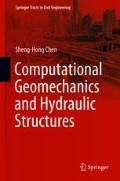Abstract
This chapter begins with a laboratory experiment showing that the conventional BEA performs well in the safety calibration for the rock wedge, but it is not equally competent in the deformation assessment. Since the foundation deformation could be important for indeterminate structures (e.g. arch dams), a pertinent improvement is desirable. The crucial breakthrough is achieved by the displacement interpolation within the block element using mapped nodal displacements bound at an overlay element. Then, with the deformation compatibility condition of rock blocks and discontinuities as well as their elasto-viscoplastic constitutive relation, the operation of the virtual work principle produces the governing equation for the solution of these mapped nodal displacements. A practical \(p\)-refinement strategy is further implemented by checking and controlling the energy norm error tolerance of each block element. This chapter is closed with a number of validation examples (cantilever, gravity dam) and one engineering application case concerning dam-foundation system, to the latter a parallel physical test is demonstrated for cross-reference.
Access this chapter
Tax calculation will be finalised at checkout
Purchases are for personal use only
References
Chang CT. Nonlinear dynamic discontinuous deformation analysis with finite element meshed block system. Ph.D. thesis, University of California at Berkeley (USA); 1994.
Chen SH. Numerical analysis and model test of rock wedge in slope. In: Pasamehmetoglu AG, et al., editors. Proc Int Symp on Assessment and Prevention of Failure Phenomena in Rock Engineering. Rotterdam (Netherlands): AA Balkema; 1993. p. 425–9.
Chen SH. A new development in elastic-viscoplastic block theory of rock masses. In: Siriwardane HJ, Zaman MM, editors. Proc 8th Int Conf Comp Meth Adv Geomech. Rotterdam (Netherlands): AA Balkema; 1994. p. 2235–40.
Chen SH. Hydraulic structures. Berlin, Germany: Springer-Verlag; 2015
Chen SH, Li YM, Wang WM, Shahrour I. Analysis of gravity dam on a complicated rock foundation using an adaptive block element method. J Geotech Geoenviron Eng, ASCE. 2004;130(7):759–63.
Cundall PA. A computer model for simulating progressive, large-scale movement in blocky rock system. In: Rock fracture, Proc Symp ISRM. Nancy (USA): ISRM; 1971. p. 129–136.
Cundall PA. Formulation of three-dimensional distinct element model. Part 1. A scheme to detect and represent contacts in system composed of many polyhedral blocks. Int J Rock Mech Min Sci & Geomech Abstr. 1988;25(3):107–116.
Hart R, Cundall PA, Lemos J. Formulation of three-dimensional distinct element model. Part 2. Mechanical calculations for motion and interaction of a system composed of many polyhedral blocks. Int J Rock Mech Min Sci & Geomech Abstr. 1988;25(3):117–125.
Koo CY, Chern JC. The development of DDA with third order displacement function. In: Salami R, Banks D, editors. Proc of the 1st international forum on discontinuous deformation analysis (DDA) and simulations of discontinuous media. Albuquerque (USA): TSI Press; 1996. p. 342–9.
Lin JS, Lee DH. Manifold method using polynomial basis function of any order. In: Salami R, Banks D, editors. Proc of the 1st international forum on discontinuous deformation analysis (DDA) and simulations of discontinuous media. Albuquerque (USA): TSI Press; 1996. p. 365–72.
Owen DRJ, Hinton E. Finite elements in plasticity: theory and practice. Swansea (UK): Pineridge Press Ltd; 1980.
Shi GH. Discontinuous deformation analysis: a new numerical model for the statics and dynamics of deformable block structures. Eng Comput. 1992;9(2):157–68.
Shyu K. Nodal based discontinuous deformation analysis. PhD thesis, University of California at Berkeley (USA); 1993.
Wang WM, Chen SH. A new implementation of elastic-viscoplastic block theory for rock masses. In: Kundu T, Desai CS, editors. Proc. 10th international conference on computer method and advances in geomechanics. Rotterdam (Netherlands): AA Balkema; 2001, 417–422.
Author information
Authors and Affiliations
Corresponding author
Rights and permissions
Copyright information
© 2019 Springer Nature Singapore Pte Ltd.
About this chapter
Cite this chapter
Chen, Sh. (2019). Adaptive Techniques in the Block Element Analysis. In: Computational Geomechanics and Hydraulic Structures. Springer Tracts in Civil Engineering . Springer, Singapore. https://doi.org/10.1007/978-981-10-8135-4_10
Download citation
DOI: https://doi.org/10.1007/978-981-10-8135-4_10
Published:
Publisher Name: Springer, Singapore
Print ISBN: 978-981-10-8134-7
Online ISBN: 978-981-10-8135-4
eBook Packages: EngineeringEngineering (R0)

